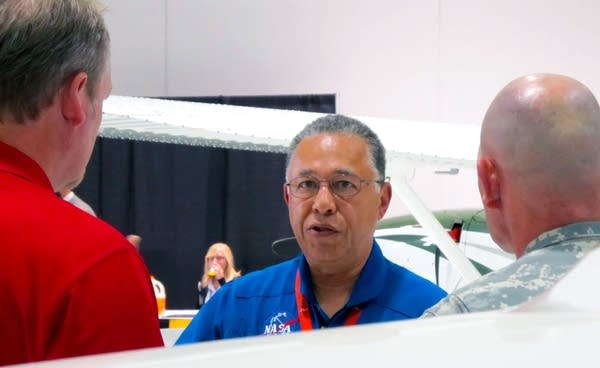NASA, UND test new sensing technology for unmanned aircraft
Go Deeper.
Create an account or log in to save stories.
Like this?
Thanks for liking this story! We have added it to a list of your favorite stories.

NASA is testing technology developed at the University of North Dakota that could help unmanned aircraft share the airspace safely. The challenge is to ensure the unmanned aircraft can avoid collisions with other planes in the sky.
Two small planes take off from the Grand Forks International Airport. One is a NASA research plane designed to be flown by a human pilot or a computer. A pilot flies the plane to a test area before the computer takes over.
A University of North Dakota plane plays the role of intruder. The intruder aircraft broadcasts a signal with its position, speed and altitude. The pilot flies on a collision course with the NASA aircraft, prompting the computer in that plane to take evasive action.
Dozens of these test flights have taken place in the North Dakota skies over the past two weeks and in a nearby hanger, where NASA's Kathy Barnstorff observes on a monitor.
Turn Up Your Support
MPR News helps you turn down the noise and build shared understanding. Turn up your support for this public resource and keep trusted journalism accessible to all.
"I see the planes heading toward one another almost like they're head on," Barnstorff said. "And then the computer software code will take it just one time and maneuver the Cirrus away from the intruder plane. It's a pretty phenomenal thing to see."

This is part of the quest for what some call the holy grail of aviation: a computer that can detect and avoid other aircraft with skill equal to a human in the pilot seat.
This is important because Congress has charged the FAA with developing rules to allow unmanned aircraft to fly in the national airspace. But that can only happen if those unmanned aircraft can fly safely among other aircraft.
In dozens of tests, the computer has reacted in time to avoid a collision, said Jeff Mittelman with MITRE, a government-funded research and development company in Virginia. Mittelman has worked with University of North Dakota faculty and students to develop this avoidance system.
This video provided by NASA explains the collision-avoidance system being developed and tested at the university in Grand Forks, N.D.
"We're very pleased with what we're seeing. And we've still got a ways to go," Mittelman said. "But I think it's going to prove that this is a viable technology that everybody can move forward with in the future."
This is one piece of a larger air safety puzzle, he said. Safe use of unmanned aircraft will also require on-board cameras and perhaps, radar systems. The FAA is developing a next-generation air traffic control system. That system will require many aircraft to carry equipment that broadcasts location information. The computer avoidance system being developed and tested at the university in Grand Forks could be used for both piloted and unmanned aircraft.
A market-ready collision-avoidance system is still a few years away, UND associate professor Mark Askelson said. But he calls this computer system a transformative technology for the aviation industry.
"This is something that we've been developing for years and testing incrementally, and now we've built up to the point where we can perform these kind of tests," Askelson said. "It is a multi-year process. It does take time to think it through, work it through, and do it right."
And it will take months to analyze all the data collected during these tests. That information will help engineers improve the technology.

Frank Jones, who leads this research effort for the NASA Langley Research Center, said this project can serve as a model for solving tough technical challenges.
"What I really enjoy about it is that this is the way national problems should be solved. You need to bring a team together with multiple skills and capabilities and work as a team," Jones said. "Because no one entity is going to solve these problems."
NASA plans to return to North Dakota next summer to test the latest unmanned aircraft navigation technology.
Dear reader,
Political debates with family or friends can get heated. But what if there was a way to handle them better?
You can learn how to have civil political conversations with our new e-book!
Download our free e-book, Talking Sense: Have Hard Political Conversations, Better, and learn how to talk without the tension.






